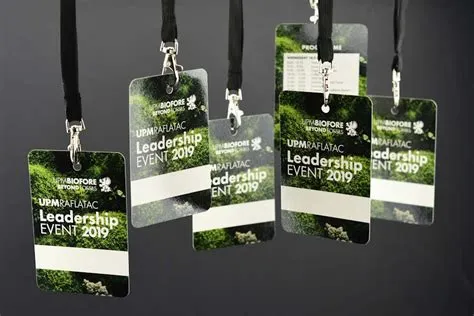Hey there, business owners and design enthusiasts! Ever stopped to think about those little rectangles of plastic – your employee ID cards? They’re more than just a way to get into the office; they’re a reflection of your brand, a symbol of your company culture, and even a tiny piece of your environmental footprint. And guess what? ID card design is evolving faster than you might think. We’re moving beyond the standard plastic and embracing innovation in materials, technology, and design. Let’s dive into the exciting trends shaping the future of business ID cards.
The Rise of Biodegradable ID Cards: A Greener Approach
Let’s face it, mountains of plastic ID cards end up in landfills each year. That’s not exactly a sustainable practice, is it? Fortunately, eco-consciousness is trending, and that includes the business ID card world. The demand for [eco-friendly ID card materials](https://amazing.biz.id/eco-friendly-id-card-materials) is rising, and we’re seeing a boom in biodegradable options. Imagine ID cards made from materials like recycled paper, bamboo, or even plant-based plastics. These alternatives offer a significantly smaller environmental impact compared to traditional PVC.
Choosing biodegradable materials isn’t just about feeling good; it’s smart business. Consumers are increasingly drawn to companies that prioritize sustainability, and having environmentally friendly ID cards is a fantastic way to showcase your commitment. It’s a win-win: you reduce your carbon footprint and enhance your brand image simultaneously. Think of it as a subtle yet powerful marketing tool that speaks volumes about your values.
Beyond Biodegradables: A Multifaceted Approach to Sustainable ID Cards
But sustainable design goes beyond just the materials. Think about the entire lifecycle of your ID card, from production to disposal. Sustainable printing techniques, such as using soy-based inks or reducing overall ink usage, are becoming increasingly popular. These [eco-friendly printing techniques](https://amazing.biz.id/eco-friendly-printing-techniques) lessen the environmental burden associated with card production. It’s like baking a cake – you can use the best ingredients, but if you bake it inefficiently, you might still waste resources. Similarly, sustainable ID cards demand sustainable production processes.
Moreover, consider the longevity of your ID cards. A more durable ID card might mean replacing them less frequently, thereby reducing waste in the long run. This dovetails nicely with the broader movement towards [sustainable and eco-friendly tech](https://amazing.biz.id/tag/sustainable-and-eco-friendly-tech), demonstrating that business can be both profitable and environmentally responsible.
Embracing Technology: Smart Cards and Beyond
The evolution of business ID cards isn’t just about sustainability; it’s also about functionality. Technology is weaving its way into the design process, creating smart cards packed with innovative features. These aren’t just simple identification tools anymore; they can serve as access keys, payment methods, and even health trackers.
Imagine the possibilities: An ID card embedded with a chip that unlocks doors, verifies employee credentials, and even tracks employee attendance. Or consider incorporating contactless payment functionality, streamlining transactions and making daily life more efficient. This isn’t science fiction; [technology-integrated ID cards](https://amazing.biz.id/technology-integrated-id-cards) are already a reality and becoming increasingly common. This technology also opens up new avenues for enhancing security and access control.
This integration requires careful consideration of security protocols. Protecting sensitive employee data is paramount, and it’s crucial to partner with reputable providers who prioritize data privacy and security. [Security and access solutions](https://amazing.biz.id/tag/security-and-access-solutions) are integral to the design of these high-tech ID cards.
The Power of Design: Branding and Customization
Let’s be honest, a well-designed ID card is a beautiful thing. It’s a chance to showcase your brand’s personality and aesthetics. Beyond mere functionality, your ID card design is a powerful tool for projecting your company’s image. Think of it as a miniature billboard that your employees carry around every day. Doesn’t that deserve some careful thought?
[Modern ID card design ideas](https://amazing.biz.id/modern-id-card-design-ideas) range from minimalist and sleek to bold and colorful. The possibilities are truly endless! You can tailor your design to reflect your brand’s identity, incorporating your logo, color palette, and overall brand aesthetic. In essence, your ID card becomes a tangible expression of your company culture.
Industry-Specific ID Cards: Tailoring Design to Need
The needs of a construction company differ drastically from those of a tech startup, right? Similarly, ID card design should reflect the specific needs and characteristics of different industries. This means adapting design elements, materials, and functionalities to align perfectly with the nature of the work.
[Industry-specific ID card designs](https://amazing.biz.id/industry-specific-id-card-designs) can incorporate features like specialized pockets for tools, different levels of security access, or even unique design elements that reflect the industry’s identity. For example, a healthcare ID card might require specific information like blood type or allergies, while a construction worker’s ID might need a rugged, durable construction to withstand tough working conditions. [Functional aspects of industry-specific ID cards](https://amazing.biz.id/tag/functional-aspects-of-industry-specific-id-cards) are crucial in ensuring efficiency and safety.
Customization and Personalization: The Human Touch
Beyond industry-specific designs, there’s an increasing trend toward personalizing ID cards. Imagine incorporating employee photos, names, and even a small personal touch to make each card unique. This adds a human element to a typically impersonal item, fostering a sense of belonging and pride. [Customization and personalization in ID card design](https://amazing.biz.id/tag/customization-and-personalization-in-id-card-design) are powerful ways to strengthen employee engagement and company culture.
The Future of Business ID Cards: A Blend of Style, Sustainability, and Technology
The future of business ID cards is bright, and the trends we’ve discussed – sustainability, technology integration, and innovative design – are shaping a new era of identification. We’re seeing a shift towards a more holistic approach, considering not just the visual appeal but also the environmental impact and technological capabilities of these seemingly insignificant pieces of plastic (or, increasingly, more eco-friendly alternatives!). It’s about finding the perfect blend of style, sustainability, and smart technology to create ID cards that are both functional and reflect the values of your company. It’s about making a statement, not just providing an identification tool. Remember, your ID card is a miniature reflection of your brand, and it should communicate your values just as effectively as your marketing campaigns. So choose wisely.
Conclusion
The world of business ID cards is transforming rapidly. We are moving beyond simply identifying employees and heading toward a future where ID cards seamlessly integrate sustainability, technology, and sophisticated design. By embracing biodegradable materials, integrating smart technologies, and focusing on industry-specific designs, businesses can create identification tools that are both effective and reflect their commitment to a greener, more innovative future. Remember, your ID card is not just a functional tool, but also a powerful brand ambassador and statement of your company’s values.
FAQs
1. Are biodegradable ID cards as durable as traditional PVC cards? Biodegradable materials vary in durability. Some are designed to be just as robust, while others might require more careful handling. The choice depends on your specific needs and the materials used.
2. How much more expensive are biodegradable ID cards compared to traditional ones? The price difference varies depending on the material and production methods. While some biodegradable options might be slightly more expensive upfront, the long-term benefits in terms of sustainability and brand image often outweigh the initial cost.
3. What security features are available for biodegradable ID cards? Many security features available for traditional PVC cards can also be incorporated into biodegradable alternatives, such as holograms, watermarks, and UV printing. You just need to find a reputable supplier specializing in secure biodegradable ID cards.
4. Can I personalize my biodegradable ID cards? Absolutely! Personalization options for biodegradable ID cards are very similar to traditional ones, allowing you to incorporate employee photos, names, and even unique design elements to create a sense of identity and belonging within your company.
5. Where can I find more information about sustainable ID card solutions? For a deeper dive into sustainable ID card options, check out our blog: [https://amazing.biz.id/blog](https://amazing.biz.id/blog) for more insights and resources. We regularly update our site with new information on the latest trends and technologies.

